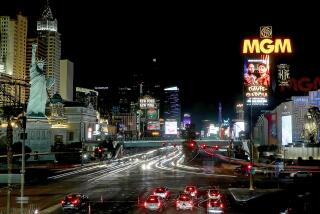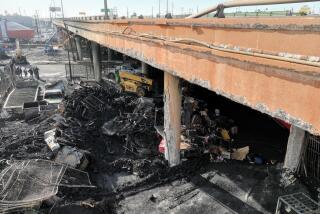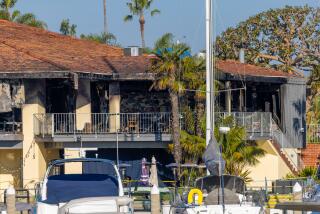Hotel industry improves on fire safety practices
Smoke billowing from the 32-story Monte Carlo Resort & Casino last month made dramatic TV footage, recalling the 1980 blaze that raced through the former MGM Grand in Las Vegas and killed more than 80 people.
No one died in the recent Monte Carlo blaze, which firefighters knocked down in less than 90 minutes. And that tells a lot about how far the hotel industry has come in its quest to protect guests from fire.
So does this statistic: Since 1980, the number of structural fires reported each year in U.S. hotels and motels has dropped by about two-thirds, according to the National Fire Protection Assn., or NFPA.
“I suspect the average person is much safer in a hotel room than in their home,” said David Stipanuk, an expert on lodging facilities and an associate professor at the School of Hotel Administration at Cornell University in Ithaca, N.Y.
Few homes are equipped with fire sprinklers, Stipanuk said; many hotels are. Homes often lack the hard-wired (non-battery-operated) smoke detectors that are required in hotels under the widely adopted fire association standards, he said.
Hotel fires, of course, still occur, and not without consequences.
Seventeen people, most suffering minor smoke inhalation, sought medical treatment after the Monte Carlo fire, casino and Clark County officials said. Each year, a total of 10 civilians die and 140 are injured, on average, in nearly 4,000 U.S. lodging fires.
But most hotel fires are non-events, quickly extinguished and therefore little noticed, said Ron Coté, principal life safety engineer for the fire protection association, based in Quincy, Mass.
“It’s these success stories you’re not hearing about,” he said.
Several experts I spoke with traced the step-up in fire-safety practices to the 1980 MGM Grand blaze and a second one, less than three months later, that killed eight people at the Las Vegas Hilton. (Another hotel fire killed nearly 100 in 1986 at the Dupont Plaza in San Juan, Puerto Rico, according to the NFPA.)
Investigators at the time said flammable furnishings, inadequate fire barriers, lack of automatic sprinklers, insufficient exits, faulty electrical grounding and failure of alarms contributed to deaths at the two Las Vegas hotels.
Those fires “absolutely raised awareness” of safety issues, Stipanuk said; hotel companies responded by using more fire-resistant materials. More states began adopting the NFPA’s Life Safety Code, which specifies hundreds of steps, including sprinklers, alarms, exit plans and staff training, to reduce fire risk, Coté said.
Today, nearly 40 states use the NPFA code for various structures, including lodging, the organization says. Other states apply codes with similar provisions.
But fire laws are still a patchwork. They vary from state to state and even county to county, because the federal government exercises little jurisdiction in this area, Stipanuk said.
The Occupational Safety and Health Act does mandate fire extinguishers, standpipes, evacuation plans and other steps in workplaces, he said. And the U.S. Hotel and Motel Safety Act of 1990 requires federal employees and conferences to use hotels with smoke detectors and automatic fire sprinklers.
Issues remain even in Nevada, which is said to enforce some of the strictest fire codes in the nation.
Union Erectors, the Las Vegas contractor that Clark County investigators blamed for igniting the Monte Carlo blaze, lacked proper permits, and its workers failed to post a fire watch or put down slag mats to catch molten metal, the county said. Anita Hershberger, co-owner of Union Erectors, which has reportedly denied blame, declined to comment.
The flames quickly devoured part of the Monte Carlo’s facade, leading to speculation about its flammability. Alan Feldman, spokesman for MGM Mirage, which runs the hotel, said that foam-like material in the facade, “like most materials” is flammable to some degree but that he had no concern about its safety.
Dan Kulin, a Clark County spokesman, declined to comment, saying investigators were still studying the materials involved. But he did note that sheet rock and concrete block on the back of the facade were fire-resistant.
According to Feldman, heat sensors in rooms triggered alarms. Thousands of people, he said, were evacuated in about 30 minutes from the hotel, which expected to reopen some rooms and services last week.
Not a perfect record, to be sure. But the Monte Carlo fire was far from the disasters of earlier decades.
jane.engle@latimes.com
More to Read
Sign up for The Wild
We’ll help you find the best places to hike, bike and run, as well as the perfect silent spots for meditation and yoga.
You may occasionally receive promotional content from the Los Angeles Times.






